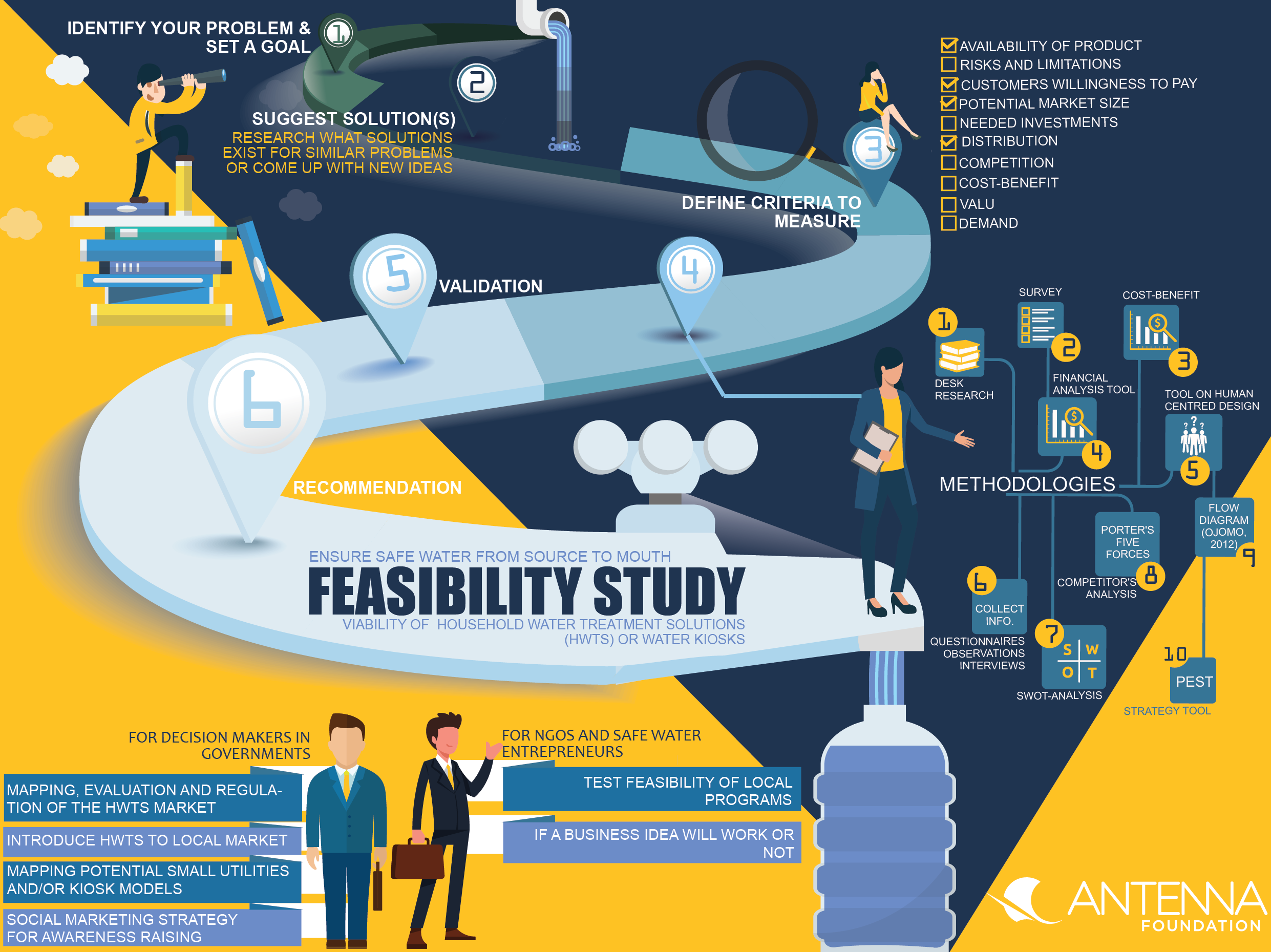Executive Summary

A feasibility study assesses the practicability of a specific project within a specific context and in regard to specific set of criteria and factors to be chosen. This helps organizations to decide whether a project shall be started or not, or what parameters have to be changed in order to implement it. This paper provides safe water enterprises, NGOs and governments with insights on how to start identifying feasible safe water solutions and technologies for a certain market and area of intervention. The case study of Spouts in Uganda provides insights on what aspects a market-based initiative founded its decisions to start a local ceramic water filter production and distribution business.
Subscribe here to the new Sanitation and Water Entrepreneurship Pact (SWEP) newsletter. SWEP is a network of organizations joining hands to help entrepreneurs design and develop lasting water and sanitation businesses.
What is a feasibility study about?
A feasibility study looks at a set of criteria in order to provide decision makers with a recommendation, whether a specific solution is feasible and viable in a certain context or not. The recommendation is based on collected and analysed information looking at the specifically defined criteria. It entails the advantages, disadvantages, risks, costs etc. for solving the specific problem.
In the context of market-based safe water initiatives, a feasibility study allows a recommendation about the viability of solutions for household water treatment solutions (HWTS) or water kiosks (or a combination of both) for a specific context or geography.
Why is a feasibility study crucial?
The new SDG 6 focuses on the safe drinking water to ensure safe water from source to mouth, brings new challenges that require new and innovative approaches to meet people’s needs. But where and how to start from in order to come up with a viable solution? A feasibility study can help identifying a solution from existing alternatives for solving a specific problem. For delivering safe water at the household level a feasibility study helps decision makers to indicate to what degree the implementation of HWTS (through public delivery or business) or setting up water kiosks will be feasible for a specific geographic area.
For whom is a feasibility study interesting?
Various audiences can use a feasibility study for the evaluation of safe water technologies:
1. For decision makers in governments it can help finding solutions for:
- Mapping, evaluation and regulation of the emerging HWTS market. With new products appearing for instance every month in the Asian market, it is highly difficult to determine the quality and the affordability of HWTS systems and which ones are most feasible and viable for the context of a specific country.
- In some countries no HWTS products are reaching local markets so far. A feasibility study can also reveal what the reasons are. Accordingly a strategy can be drafted to consider the support or the creation of a national/social enterprise that could deliver HWTS products in the long term.
- Mapping of potential for small utilities and/or feasibility of kiosk models.
- Aspects of a social marketing strategy that would be most feasible and effective for awareness raising among all citizens in the country.
2. For decision makers from providers of products/services (NGOs and safe water entrepreneurs):
- NGOs’ local programs can test their feasibility using the Technology Applicability Framework (TAF), a methodology for the assessment of applicability of WASH technologies in developing countries with focus on SSA. The TAF tool supports the WASH sector to plan and monitor technology introduction processes (For further details please see tool on Enabling Environment.). The evaluation can be used to further document the strategy and embed all actors in the decision-making board (RWSN, 2016).
- For safe water enterprises, the feasibility study provides insights on how a business idea will work or not. It is not a guarantee of success but reduces the risks taken by an entrepreneur before committing to an implementation. Feasibility studies are just as important for social enterprises as for any other form of business.
How can a feasibility study be conducted?
Carrying out a feasibility study includes different steps:
1. Identify your problem and set a goal/outcome for the potential intervention.
2. Suggest solution(s) to reach the suggested goal/ outcome.
- Do research on what solutions exist for similar problems or come up with new ideas. A broad range of solutions can be accessed here.
3. Define criteria/ indicators to measure how the proposed solution complies with the set outcome / goal:
- Availability of the product, local experience to implement and offer the service etc.
- Cost-benefit assessment of the specific options in place (costs to produce / import the goods or deliver the service and the benefit)
- Value proposition customers are looking for (see tool on value proposition)
- Demand in place for the specific solutions suggested (example of market analysis here)
- Potential market size that the solution could serve (market survey template here)
- Willingness to pay of customers for the solution (template here)
- Competition in place (bottled water, no treatment etc.)
- Risks and limitations of the solution (see tool on risk management)
- Distribution requirements for the goods or services
- Investments needed (analysis template here)
The question arises now what methodologies serve best to assess the relevant aspects and indicators identified:
4. Methodologies
- Desk or secondary research are useful to find out what has happened in the past and learn from it. To complement the evidence findings, undertaking new research is useful also. Methodologies can include: qualitative asking open questions to gain a general understanding of how people feel or quantitative surveys ask multiple choice style questions to gain factual / statistical answers.
- Different techniques for gathering this information are:
A variety of additional tools can help you discussing the different aspects and criteria of a feasibility study further:
- Overview of data collection tools
- Cost-benefit tool
- SWOT-analysis tool > SWOT sswm
- Strategy tool PEST (Politic, Economic, Socio-Cultural and Technological-factors)
- Porter's Five Forces - Competitor's analysis
- See tool on financial analysis for more information
- To identify what solution is most demanded by customers please consider the tool on Human Centred Design approach.
- To identify whether a local HWTS production is feasible, the flow diagram (OJOMO, 2012) supports decision-making.
- Doingbusiness summarises what it means for a company to start a technology-based business and what challenges might need to be overcome during business inception.
5. Validation: Validate the gathered information by a set of criteria (e.g. clarity of aim of the feasibility study, unbiased evaluation and identification criteria, is the gathered information representative, external validity of the findings could be checked trough an external person or evaluator) for example use GRACE principles and refer to checklist for evaluating methodological quality of validation studies
6. Make a recommendation for the specific solutions: what are advantages, disadvantages, risks, costs etc. for solving the specific problem and hand it over to decision maker.
The case study about SPOUTS of Water provides insights on how a safe water start-up identified the most suitable HWTS product in Uganda.
Defining the Enabling Environment for HWTS using the IAD Framework
Presentation hold on October 31, 2012 at Water and Health Conference 2012 in Chapel Hill, North Carolina, USA.
OJOMO, E. (2012): Defining the Enabling Environment for HWTS using the IAD Framework. URL [Accessed: 23.07.2018]Technologies and Technology Applicability Framework
Sustainability and Scale-up of Household Water Treatment and safe Storage Practices: Enablers and Barriers to effective Implementation
This paper provides insights from the ground on scaling up sales of household water treatment products (HWTS). The data collected is based on interviews carried out in over 25 countries. 47 enabling factors as well as barriers were identified to sustaining and scaling up HWTS. The findings were clustered as: user guidance on HWTS products; resource availability; standards, certification and regulations; integration and collaboration; user preferences; and market strategies.
OJOMO, E. et al. (2015): Sustainability and Scale-up of Household Water Treatment and safe Storage Practices: Enablers and Barriers to effective Implementation. In: International Journal of Hygiene and Environmental Health: Volume 218 , 704–713. URL [Accessed: 23.07.2018] PDFFeasibility Study
Thesis: Entrepreneurship and Business Innovation
International Scheme to Evaluate Household Water Treatment Technologies
WHO established the international scheme to evaluate HWTS. The Scheme aims to consistently and independently evaluate the performance of HWTS against WHO performance recommendations. The report provides the result of these assessments from a range of HWT technologies including solar, chemical, filtration and ultraviolet (UV). It highlights that of the ten HWT products evaluated, eight were found to meet WHO performance recommendations. The report also recommends specific actions at the national level needed to ensure that health gains from HWT are realized, including strengthening regulation and evaluation of HWTS.
WHO (EDITOR) (2016): International Scheme to Evaluate Household Water Treatment Technologies. Geneva: World Health Organisation URL [Accessed: 20.04.2018]Nanofiltration for Safe Drinking Water in Underdeveloped Regions – A Feasibility Study
Working with the bottom of the pyramid - success in low-income markets
The book explores various ways of how to do business at the bottom of the economic pyramid. It provides insights on how to develop inclusive business models and an overview on variety of potential markets to engage as social enterprise.
Confederation of Danish Industries (2007): Working with the bottom of the pyramid - success in low-income markets. URL [Accessed: 23.07.2018]Feasibility study of an electrodialysis system for in-home water desalination in urban India
The article shows how a feasibility study for desalination household water treatment solutions can be performed.
This is an open access article under the CC BY-NC-ND license.
NAYAR, K. et al. Feasibility study of an electrodialysis system for in-home water desalination in urban India. In: Development Engineering: Volume 2 , 38-46. URL [Accessed: 23.07.2018]Use of ceramic water filters in Cambodia: improving household drinking water quality
Field study on how to develop ceramic water filters in Cambodia to improve household drinking water quality. License: CC BY 3.0 IGO
BROWN, J. and SOBSEY, M. (2007): Use of ceramic water filters in Cambodia: improving household drinking water quality. World Bank: URL [Accessed: 23.07.2018]CAWST: HWTS options
Exhaustive list and case studies on Household Water Treatment and Safe Storage options.


